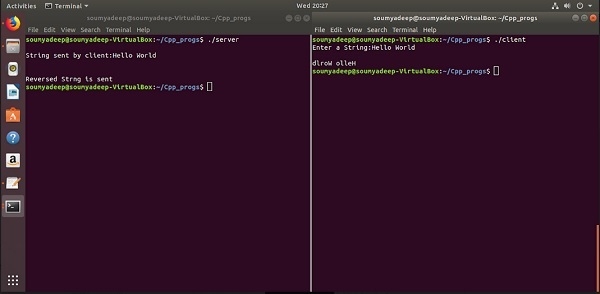
 Data Structure
Data Structure Networking
Networking RDBMS
RDBMS Operating System
Operating System Java
Java MS Excel
MS Excel iOS
iOS HTML
HTML CSS
CSS Android
Android Python
Python C Programming
C Programming C++
C++ C#
C# MongoDB
MongoDB MySQL
MySQL Javascript
Javascript PHP
PHP
- Selected Reading
- UPSC IAS Exams Notes
- Developer's Best Practices
- Questions and Answers
- Effective Resume Writing
- HR Interview Questions
- Computer Glossary
- Who is Who
Reverse a string in C/C++ using Client Server model
Here we will see how we can create a system, where we will create one client, and a server, and the client can send one string to the server, and the server will reverse the string, and return back to the client.
Here we will use the concept of socket programming. To make the client server connection, we have to create port. The port number is one arbitrary number that can be used by the socket. We have to use the same port for client and the server to establish the connection.
To start the program, start the server program first −
gcc Server.c –o server
Then start client program −
gcc Client.c –o server
Now the server will wait for a string from client. We have to take a string as input from the client side, then it will be transferred. The server will print the string, and also send the reversed string. After that client will print the reversed string from server.
Example
//Client Side Code
#include <arpa/inet.h>
#include <netinet/in.h>
#include <stdio.h>
#include <stdlib.h>
#include <string.h>
#include <sys/socket.h>
#include <unistd.h>
#include <string.h>
#define PORT 4000
main() {
struct sockaddr_in address;
int my_socket = 0, valread;
struct sockaddr_in server_address;
char str[100];
int l;
printf("Enter a String:");
fgets(str, 100, stdin); //read string until new line character is pressed
char buffer[1024] = { 0 }; //create a buffer and fill with 0
// Creating socket file descriptor
if ((my_socket = socket(AF_INET, SOCK_STREAM, 0)) < 0) {
printf("\nUnable to create Socket \n");
return -1;
}
memset(&server_address, '0', sizeof(server_address));
server_address.sin_family = AF_INET;
server_address.sin_port = htons(PORT);
if (inet_pton(AF_INET, "127.0.0.1", &server_address.sin_addr) <= 0) {
printf("\nThe address is not supported \n");
return -1;
}
// connect the socket
if (connect(my_socket, (struct sockaddr*)&server_address, sizeof(server_address)) < 0) {
printf("\nUnable to connect to the server \n");
return -1;
}
l = strlen(str);
send(my_socket, str, sizeof(str), 0); // send message to server side
valread = read(my_socket, str, l); // read message sent by server
printf("%s\n", str);
}
Example
//Server Side Code
#include <netinet/in.h>
#include <stdio.h>
#include <stdlib.h>
#include <string.h>
#include <sys/socket.h>
#include <unistd.h>
#include <string.h>
#define PORT 4000
char *strrev(char *str){
char *p1, *p2;
if (! str || ! *str)
return str;
for (p1 = str, p2 = str + strlen(str) - 1; p2 > p1; ++p1, --p2){
*p1 ^= *p2;
*p2 ^= *p1;
*p1 ^= *p2;
}
return str;
}
main() {
int server_fd, new_socket, valread;
struct sockaddr_in address;
char str[100];
int addrlen = sizeof(address);
char buffer[1024] = { 0 };
int i, j, temp;
int l;
char* message = "Welcome to the server"; //initial message
// Creating socket file descriptor
if ((server_fd = socket(AF_INET, SOCK_STREAM, 0)) == 0) {
perror("Socket connection failed");
exit(EXIT_FAILURE);
}
address.sin_family = AF_INET;
address.sin_addr.s_addr = INADDR_ANY;
address.sin_port = htons(PORT);
if (bind(server_fd, (struct sockaddr*)&address, sizeof(address)) < 0) { //attack with socket 4000
perror("Unable to bind with the socket 4000");
exit(EXIT_FAILURE);
}
if (listen(server_fd, 3) < 0) {
perror("Listning.....");
exit(EXIT_FAILURE);
}
if ((new_socket = accept(server_fd, (struct sockaddr*)&address,(socklen_t*)&addrlen)) < 0) {
perror("Accept");
exit(EXIT_FAILURE);
}
// read string send by client
valread = read(new_socket, str, sizeof(str));
l = strlen(str);
printf("\nString sent by client:%s\n", str);
strrev(str); //reverse the string
send(new_socket, str, sizeof(str), 0);
printf("\nReversed Strng is sent\n");
}
Output


